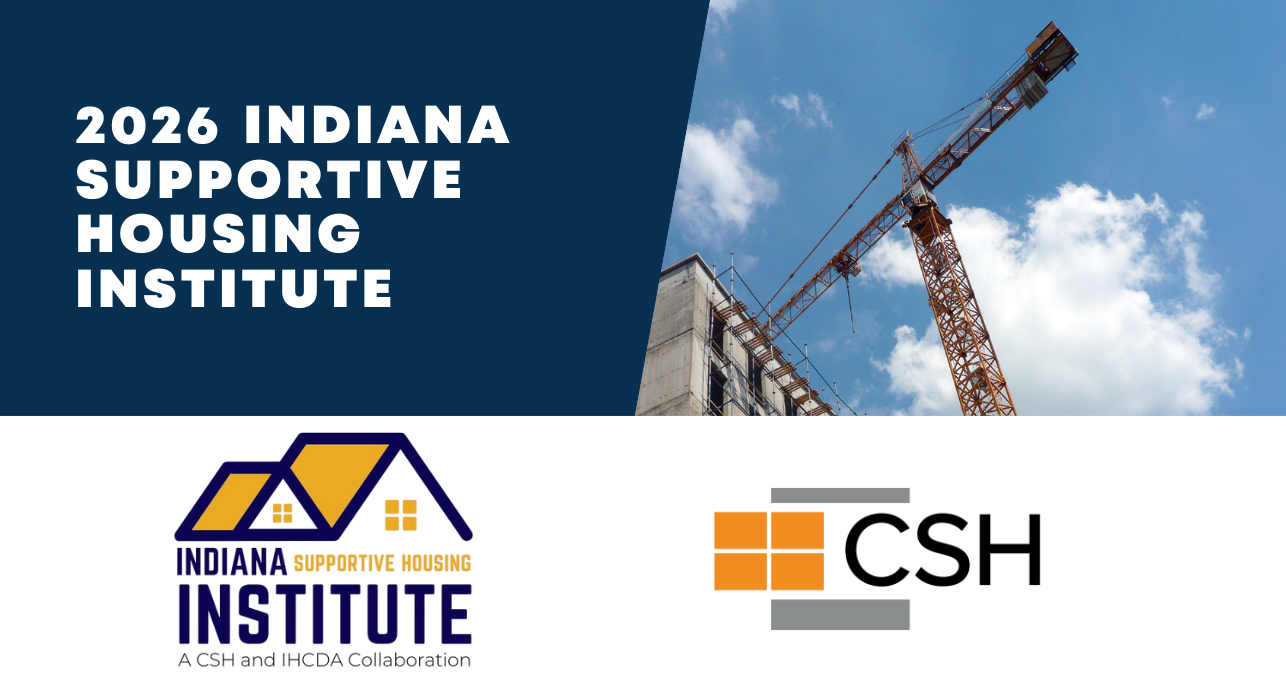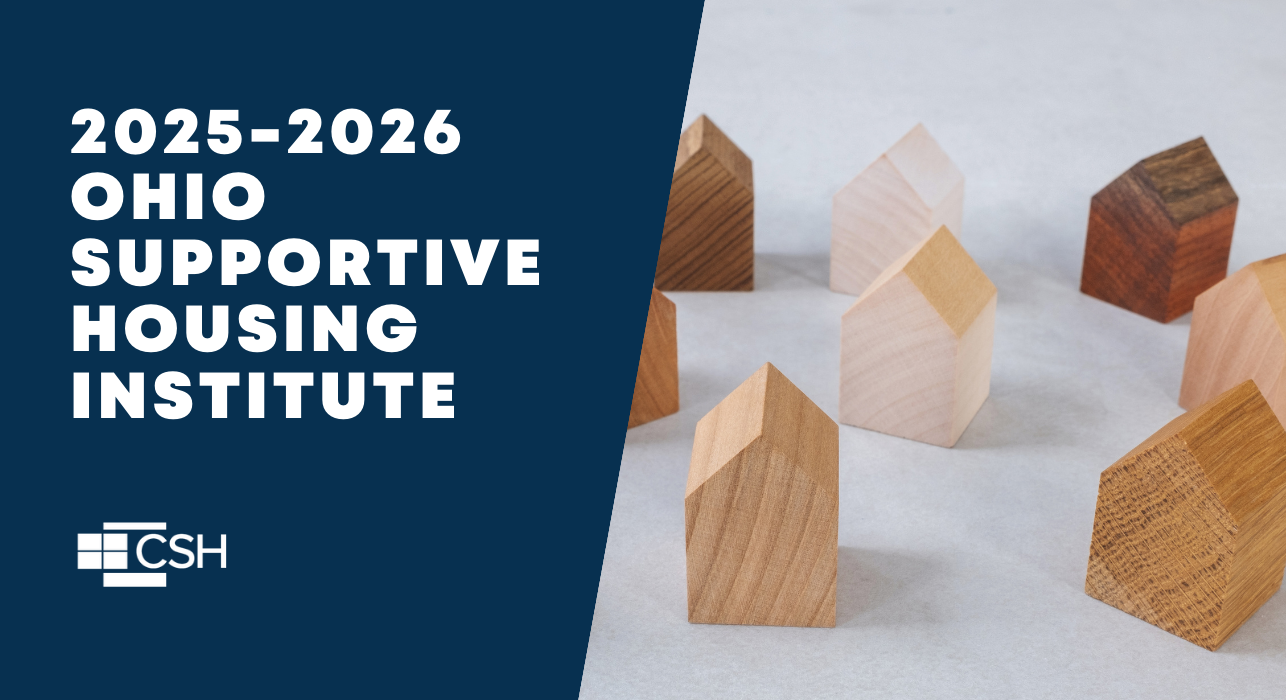This blog is for supportive housing providers, advocates, and policymakers navigating the evolving health policy landscape in 2025. We explore key questions and strategies for leveraging Medicaid to fund supportive housing and provide updates on health policy changes that impact the supportive housing industry. This work needs a strong national Medicaid program so that states can meet the needs of their constituents. We continue to advocate with congress against cuts to Medicaid.
Introduction to CSH’s Health Policy Series
CSH endeavors to provide updates on health, health policy, and activities at the federal, state, and local level in this rapidly changing environment. that impact the supportive housing, homeless, and housing sectors.
Supportive housing remains the data-driven solution. It addresses homelessness, supports people with disabilities and chronic health and behavioral health needs, assists those returning from prison or institutional settings, and aids families facing multiple obstacles to living successfully in the community.
In this inaugural post, we will highlight some areas of concern for your awareness. We then share critical questions each of us needs to consider as the federal funding environment remains perilous and the housing sector looks to build stronger partnerships with the health sector.
Quality supportive housing is an effective solution for people with multiple obstacles to attaining housing, including households with persons with disabilities who remain unable to access community housing options. Adequate service funding is essential for quality supportive housing projects and programs to meet demand and community needs.
Topics we expect to cover include:
– Medicaid financing and any proposed cuts to the Medicaid program.
– States running Health-Related Social Needs (HRSN) and Social Drivers of Health programs.
– Medicaid reentry waivers that serve persons returning to the community from incarceration and cover the services they need to have a successful transition.
– Behavioral health care and how to leverage behavioral health services to assist those experiencing homelessness and housing instability or in institutional settings.
– Aging populations and the services and support they need to obtain and maintain their housing. As an increasing number of persons age into homelessness and housing instability, partnerships between the aging and housing sectors will be an essential.
Current State of Medicaid Authorities to Cover Housing Related Services (HRS)
As of May 2025, more than 30 states have approved Medicaid authorities to cover supportive housing services via their state Medicaid program. CSH has updated our policy brief on the topic. CSH uses Housing Related Services (HRS) to designate supportive housing services covered by a state’s Medicaid program.
State HRS programs vary, but they all aim to expand safe, affordable housing for eligible Medicaid members and assist them in achieving their health and housing goals. With the proper access points and quality services that focus on health and housing stability, alongside the vision of Olmstead1 everyone can achieve their highest level of health in their community of choice.
When examining services funding, housing developers and system leaders must answer key questions about the status of their State’s use of Medicaid for HRS. Below, we outline those questions with possible answers and explore how supportive housing industry leaders can utilize these insights.
Questions to Consider When Leveraging Medicaid for Supportive Housing
1. Has my state expanded Medicaid?
This question is important because HRS is only available to people who are actively enrolled in the Medicaid program. The Kaiser Family Foundation offers a map to track which states have expanded Medicaid. They typically keep the map updated.
Medicaid expansion means that people need only prove low income to qualify for Medicaid in their state of residence. If a person has only proven low income, the state groups these individuals in “the expansion population.” As of May 2025, 41 states have expanded Medicaid in this manner. If the federal government were to decrease the current federal match to the program, however, nine states would end expansion coverage. These states are:
- Arizona
- Arkansas
- Illinois
- Montana
- New Hampshire
- North Carolina
- Utah
- Virginia
The states listed above have what is called a “trigger law,” meaning that the expansion program would automatically end if the federal funds fell below 80-90% of the federal match rate. An additional three states – Iowa, Idaho, and New Mexico – do not have automatic trigger laws, however, law requires them to address the impact of losing federal funding, which would likely lead to an end or near the end of the program.2 Supportive housing and health advocates could have an opportunity to work with their state Medicaid agencies and legislators to address these laws and ensure that individuals in their states do not lose coverage if the federal government reduces its Medicaid funding.
If your state has not expanded Medicaid, they may still cover HRS, such as in Florida and Texas. However, HRS will be limited because Medicaid enrollment is required to receive services, and fewer people will be enrolled in non-expansion states.
2. Does my state cover Housing Related Services (HRS) in its Medicaid program?
CSH’s policy brief tracks which states cover HRS in their Medicaid program and critical details, such as what services are covered and who is eligible to receive them. Medicaid policy processes take a long time. The process from state exploration of these services to state full implementation can take at least 2 to 3 years. States must take these steps before agencies can bill for services:
- Explore coverage of these services- how many people need them and what it costs to deliver quality services.
- Actively create a request to the federal government and the Centers for Medicaid and Medicare Services (CMS) to cover HRS.
- Negotiate with CMS around the submitted request.
- Have an approved submission. Develop an implementation plan and the policy to support that plan.
- Implement the program.
Knowing where your state is in this process can inform a strategic approach to engaging your state offices and influencing the process to support the values and goals of the supportive housing industry.
3. Who is covered by my state’s Housing Related Services (HRS)?
After confirming that your state provides HRS, the next question is: ‘Who is eligible?’ Few states cover these services for all potential HRS recipients. Because the program is a Medicaid health program, states will generally define populations primarily using a health lens, such as a particular diagnosis(es) or functional limitation, such as needing help with Activities of Daily Living (ADLs). These factors are called Clinical Risk Factors.
The state may also create program access requirements based on social risk factors, such as experiencing homelessness, housing instability, food insecurity, or other factors that limit the potential for achieving good health. As always, medical assistance is a foundational objective of the Medicaid program and must be central to any program.
Common examples of covered populations and common clinical and Social Risk factors include:
- People with Behavioral Health disorders. Commonly includes both mental health and substance abuse challenges.
- People with one or more chronic health conditions.
- People experiencing homelessness or housing instability. No state has an approved program focusing solely on people experiencing homelessness, and housing instability is very broadly defined. States are generally using the HUD Homeless definition while also including housing instability.3
3. How does someone access my community’s Housing Related Services (HRS)?
Once states have an approved program, state officials work with consultants to support the policy development needed to implement those programs. Critically, states must determine the Access Point for services. In other words, how does someone who likely qualifies for services prove to the State that 1) they qualify for services and 2) how to access those services? Standard processes may include leveraging Managed Care Organizations (MCOs) or a Third-Party Administrator that acts in an MCO role for everyone who might qualify for services. CSH’s Medicaid Toolkit tracks each state’s process for health centers. However, referral processes within a state will be similar regardless of the referral source.
The remainder of the year will likely bring changes to the overall health sector, particularly the Medicaid program operated by CMS.
CSH will be tracking policy issues at the federal and state levels and the impact of those changes on the supportive housing industry. We will bring that knowledge to this monthly blog series and through our community work.
For more information about health and housing services, visit csh.org/health.
Marcella Maguire, Ph.D., Director, Health Systems Integration at CSH contributed to this article.
1 Olmstead was a 1999 Supreme Court decision that determined that persons with disabilities are entitled to live in the least restrictive setting possible. Restricting persons with disabilities to institutional settings was considered unlawful discrimination.
2 For a deeper dive into these laws you can review – 9 States Poised To End Coverage for Millions if Trump Cuts Medicaid Funding – KFF Health News and Federal Funding Cuts to Medicaid May Trigger Automatic Loss of Health Coverage for Millions of Residents of Certain States – Center For Children and Families
3 HUD’s Definition of Homelessness: Resources and Guidance – HUD Exchange




